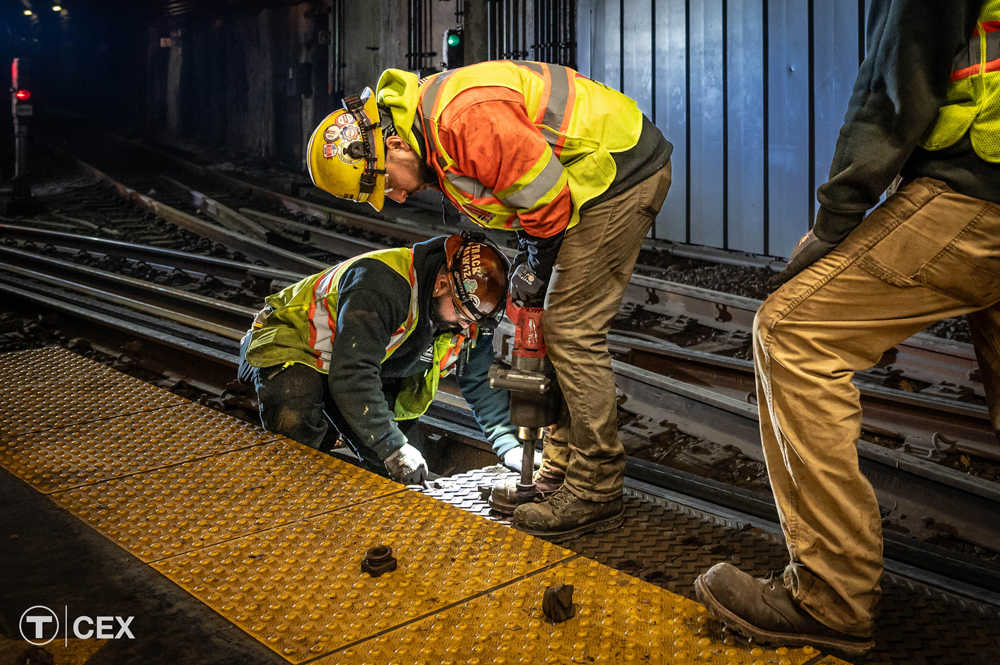
EAST ORANGE, N.J. — Eight rail transit systems will receive a total of $343 million to modernize stations, improving access for passengers including those with disabilities and injuries, under grants announced today by the Federal Transit Administration.
The grants, under the FTA’s All Stations Accessibility Program, were announced in an event at NJ Transit’s Brick Church station in East Orange. That century-old station on the Morris and Essex commuter line will receive some $83.3 million in funding for improvements including accessible platforms for level boarding, elevators, a new public address system, and renovation of a pedestrian tunnel and stairways.
Other agencies receiving funding are New York’s Metropolitan Transportation Authority; the Massachusetts Bay Transportation Authority; the Greater Cleveland Regional Transit Authority; Pittsburgh Regional Transit; the New Orleans Regional Transit Authority; the San Francisco Municipal Transportation Authority; and the Maryland Transit Administration.
“Since the passage of the Americans with Disabilities Act, great strides have been made in improving accessibility, but there is still a lot of work to accomplish,” FTA Acting Administrator Veronica Vanterpool said in a press release. “By modernizing rail systems across the country, the ASAP program provides funding to address these overdue improvements. We want to ensure that all customers can use transit systems with ease and reliability, including people with disabilities, those using mobility devices, and other users needing more accessible spaces.”
More information on NJ Transit’s Brick Church project is available here.
Along with the NJ Transit project, other awards and their planned use include:
— $156.5 million to the MTA for upgrades at five New York City Transit subway stations: Wakefield-241st Street on the 2 line; 167th Street on the 4 line in the Bronx; Kingsbridge Road; 145th Street; and 110th Street. (The last three stations on the FTA list could refer to multiple locations on the subway system; Trains News Wire is awaiting clarification from the MTA on the specific stops involved.) Work will include installation of elevators, platform updates to reduce gaps; addition of tactile platform edge warning strips; stairway repairs; and improved visual and audio announcement systems.
— $67.6 million to the MBTA to upgrade platforms at 14 stations on the light rail Green Line’s B and C branches that are not currently accessible: On the B Branch, Chestnut Hill, Chiswick Road, Packard’s Corner, South Street, and Sutherland Road, and on the C Branch, Brandon Hall, Dean Road, Englewood Avenue, Fairbanks Street, Hawes Street, Kent Street, Saint Paul Avenue; Summit Avenue, and Tappan Street. Improvements will include accessible platforms for level boarding. The MBTA released more information on its award on May 30.
— $16 million to the Greater Cleveland RTA to upgrade eight stations on the Blue Line, which will make the entire line accessible. Work will include replacing 40-year-old platforms with new concrete platforms with tactile warning strips; redesigned ramps; providing an elevated platform section for access; and improve parking stalls with curb ramps. More information from the RTA is available here.
— $8 million to Pittsburgh Regional Transit to make 10 stations on the light rail Red Line accessible. Stations included are Palm Garden, Dawn, Hampshire, Stevenson, Poplar, Arlington, Smith Road, Casswell, Highland, and Dorchester. Improvements will include providing platforms for level boarding; platform canopies; creating clear, accessible paths to the platforms, and accessible signage.
— $5.5 million to New Orleans Regional Transit to upgrade the St. Charles Streetcar route, previously announced by U.S. Rep. Troy Carter [see “New Orleans historic streetcar line to receive spark …,” News Wire, May 23, 2024]. Work will include design and construction of ADA-compliant stops and traffic studies along the corridor. Additional information from New Orleans Regional Transit is available here.
— $4.7 million to San Francisco Muni to construct platforms, wheelchair ramps, and other accessibility improvements at five light rail stops on the J-Church line and three on the M-Ocean line. The work will reduce gaps between the platform and railcar, improving access for people currently unable to use the system. Additional information from San Francisco Muni is available here.
— $1.4 million to the Maryland Transit Administration for engineering and design work to make the College Park station on MARC’s Camden Line fully accessible. The station will receive new 600-foot-long, low-level platforms, as well as additional safety improvements.
More information on the All Stations Accessibility Program is available here.
— Updated May 30 at 7 p.m. CT with links to press releases from several agencies with more details on their grants.














Where do all these millions of dollars come from?
The same place as Biden’s $320 Million Gaza pier that collapsed before it was used.
I’m NOT against subsidy for public transportation. I’m not against public funds being used for retrofitting stations for access to the disabled. What I am saying is this: full disclosure. When you buy that $2.75 subway fare, or that $45.00 Amtrak ticket, ALL the subsidies (capital and operating) should be disclosed. Including the money in this article.
Take the example of Amtrak’s newest train, the Borealis. Every Amtrak train is federally supported. The Borealis has capital and operating subsidies from the states. And someone is paying for the second platform (and the footbridge and wheelchair-accessible elevators) at MKA station in south-side Milwaukee. In any legitimate accounting system, all these subsidies would be reported as if one. Divvying up the subsidy into different buckets hides the true cost. And that’s deliberate.
Charles why don’t you just ask the State of Wisconsin for the information then you can stop asking about it here, most of the populace could care less where “… ALL the subsidies (capital and operating) should be disclosed. Including the money in this article.” comes from. If it’s benefiting the populace and not just going into some coffers to be lost to time that’s a plus, we need to take these pluses when we can.